Think about the greatest comic superheroes around today. Batman, Superman, Spider-Man, Doctor Strange, and many more can trace the roots of their inspiration back to the Pulp magazines and adventure books of the late 19th- and early 20th-Century. Before there was Batman, there was The Shadow and The Spider. Before there was Superman, there was Black Terror. Over the last century, countless writers and artists have taken ideas and inspiration from heroes (and villains) of the Pulp era. Some of those Pulp characters still make their appearances in media today.
We’ll look at the Top 15 greatest Pulp comic heroes who managed to stand the test of time by continuing to inspire fans and creators of modern comics. Some of these characters may look familiar, but others may be new to you.
By the way, if you’re interested in learning how we compiled this list, click here.
15. The Spider
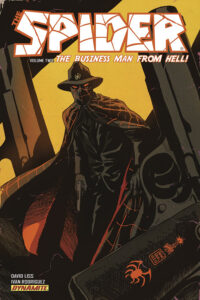
The Spider is a masked vigilante determined to bring down villains of NYC while hiding his secret life as wealthy socialite Richard Wentworth. Wentworth returned home from his service in WWI to find mobs and criminals ravaging his city, so he adopted the persona of The Spider to deal out violent justice using his gift for disguise and voice mimicry to confuse his enemies. Although his look has changed over the years, The Spider typically wears a Fedora-style hat, a mask, and a cape.
The Spider has appeared in several Pulp magazines, modern comics (most recently through Dynamite Comics), novels, and movie serials.
Interesting Fact: The Spider was inspired by and created as a direct competitor to The Shadow.
First Appearance: The Spider, vol. 1, #1 (“The Spider Strikes”) (1933) via Popular Publications
14. Daredevil
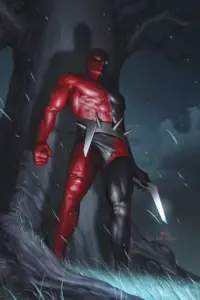
No, not Daredevil from Marvel fame. This is the first, and ORIGINAL Daredevil. First published in 1940, Bart Hill (later to be renamed Bill Hart) endured a shocking scene as a boy when his father was murdered in front of him. The killer branded Bart’s chest as a reminder to keep quiet. The experience left him mute, but he grew up determined to avenge his father’s death and see justice done in the world. Bart learned to become an expert fighter, choosing a boomerang as his weapon of choice in honor of the boomerang-shaped branding scar on his chest.
Interesting Fact: This version of Daredevil is a Public Domain character. When Dynamite Comics used the character in their Project: Superpowers series, the creators updated Daredevil’s costume into a sentient being with useful but mysterious abilities.
First Appearance: Silver Streak #6 (September 1940) via Lev Gleason Publications
13. Doc Savage
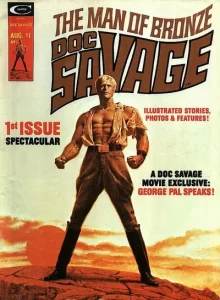
Clark Savage Jr., publicly known as Doc Savage, was raised from birth to achieve the peak of human training, development, and accomplishment. Savage has no superpowers and doesn’t wear a costume, but he uses all his skills to help others and right injustices. True to his moniker, Doc Savage is a medical doctor, a peak-level athlete, a fighting expert, inventor, explorer, scientist, master of disguises and languages, and a keen detective.
Interesting Fact: Doc Savage is sometimes referred to as the first “Superman” before DC’s Man of Steel was created.
First Appearance: Doc Savage Magazine #1 (March 1933) via Street & Smith Publications
12. Conan the Barbarian
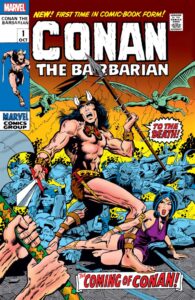
This is the part where we would give you a brief description of the character, but there’s no better way to describe the legendary sword-fighting barbarian than through the words of the character’s creator, Robert E. Howard:
“Hither came Conan, the Cimmerian, black-haired, sullen-eyed, sword in hand, a thief, a reaver, a slayer, with gigantic melancholies and gigantic mirth, to tread the jeweled thrones of the Earth under his sandaled feet.”
Interesting Fact: Conan is a Cimmerian. Cimmerians are a real-but-now-extinct race of people who occupied the Eurasian Steppes between the Black Sea and Caspian Sea circa 1,000 B.C.
First Appearance: Weird Tales (December 1932) via the magazine of the same name
11. Buck Rogers
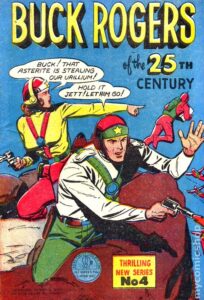
Buck Rogers began his heroic career as a soldier during World War I. When he was exposed to a mysterious gas in a mine, he was trapped in suspended animation for 500 years. Buck awoke in the middle of an intergalactic war between future factions of Earth governments, and later, assorted alien invaders.
Interesting Fact: Buck Rogers is one of only two characters on this list (the other is Conan the Barbarian) to appear in every form of media as well as video games and tabletop games.
First Appearance: Daily national newspapers (January 7, 1929) via the National Newspaper Service
10. Ka-Zar
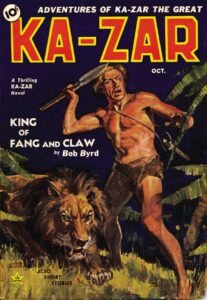
This Ka-Zar is the first character to bear the name Ka-Zar, not the current Marvel character of the same name. Got it? Good.
The first Ka-Zar refers to a young American boy, David Rand, who becomes marooned in the Congo jungle after his family plane crashes. The crash kills his mother, but David and his father survive. Sadly, David’s fortune takes a turn for the worse when his father becomes severely injured in an accident, leaving David to fend for himself. David grows up in the jungle with the help of noble jungle animals, including Zar the lion. When David grows into adulthood, he adopts the name Ka-Zar meaning “Brother of Zar the lion.”
Ka-Zar has no powers or special abilities, but he’s able to subtly communicate with wildlife after learning their sounds and mannerisms. Ka-Zar is also a master-level hunter and athlete.
Interesting Fact: Before the original Ka-Zar was replaced by the current Ka-Zar (Kevin Plunder), he traveled the world with his lion, Zar, and even helped fight alongside the Allies in WWII.
First Appearance: Ka-Zar #1 (October 1936) via the magazine of the same name
9. Flash Gordon
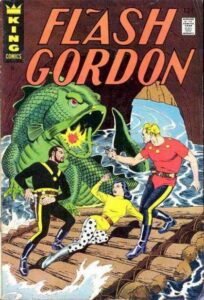
Flash Gordon is a college graduate and professional athlete. Early versions of the character depict Flash as a polo player, but the current version of Flash is described as an American football player. Flash is kidnapped and forced into a mission by Dr. Hans Zarkov to stop the planet Mongo from colliding with Earth. Along with his beautiful companion Dale Arden, Flash and Dr. Zarkov survive a series of conflicts against Mongo’s cruel dictator Ming the Merciless. The trio encounters alien enemies and allies, including the winged Hawkmen and Prince Thun of the Lion Men.
Interesting Fact: Flash Gordon is the longest-running comic strip in newspaper history. The strip ran almost continuously from its premiere date in 1934 until the strip stopped publication in 2003.
First Appearance: Daily national newspapers (January 7, 1934) via King Features Syndicate
8. The Phantom Lady
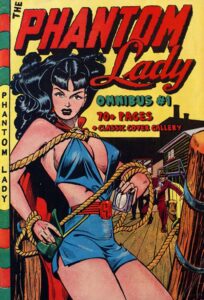
The Phantom Lady’s first appearance is notable for not starting with her origin story. Readers were introduced to the character already at the height of her crime-fighting career. Sandra Knight (the first incarnation of the character) adopted the name The Phantom Lady to fight criminals at every level of society. Her weapon of choice is a “black light” gun used to blind her enemies and render her invisible. The same “black light” technology was integrated into the headlights of her car, creating an early version of stealth capability when driving.
Interesting Fact: Police Comics #1, the anthology comic where The Phantom Lady first appeared, also includes first appearances of The Mouthpiece, Human Bomb, Firebrand, and Plastic Man of DC Comics fame.
First Appearance: Police Comics #1 (August 1941) via Quality Comics
7. Miss Fury
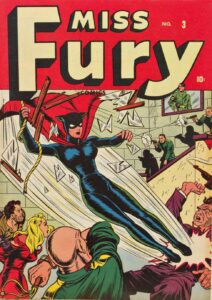
Marla Drake was given a skin-tight panther skin suit by her uncle after he returned from a visit with an African voodoo witch doctor. The suit provides its wearer with increased strength and agility, similar to a large, powerful cat.
Drake uses the suit to fight a rogues gallery of bizarrely unique criminals and thugs who threaten the city with crimes ranging from kidnapping and murder to theft. As Miss Fury, Marla Drake is the scourge of the criminal underworld, the envy of women, and the subject of desire for men everywhere.
Interesting Fact: The character of Miss Fury first appeared under the name The Black Fury in April 1941 but was later renamed Miss Fury in November of that same year.
First Appearance: Daily national newspapers (April 6, 1941) via Bell Syndicate
6. Red Sonja

One of the more modern pulp characters, Red Sonja was first conceived as an amalgam of older characters found in the writings of Robert E. Howard. While Howard did not specifically create Red Sonja as she’s known today, many of her qualities are assembled from Howard’s other female creations, including Valeria, Red Sonya of Rogatino, and Dark Agnes of Chatillon.
In her current incarnation, the Red-Haired She-Devil with a sword is famously known for her bright red hair, an impractical chainmail bikini, and her undefeated prowess with a sword. Depending on the writer, Red Sonja may be immortal and unbeatable as a result of a sworn oath of service to the god Scathach.
Red Sonja’s exploits were originally set in the swashbuckling setting of the 16th-Century. Later, her origin was retconned to fall into the same time period as Conan the Barbarian to make crossovers possible, but the two are infrequently seen together.
Interesting Fact: The retconned version of Red Sonja hails from Hyrkania, an ancient kingdom in the Middle East. Hyrkania is a real kingdom once situated in an area now occupied by the country of Iran.
First Appearance: Conan the Barbarian #23 (February 1973) via Marvel Comics
5. Zorro
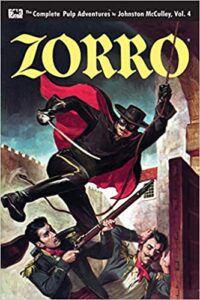
Don Diego de la Vega is a wealthy landowner in Southern California during the late 18- and early 19th-Century. Don Diego swore to uphold justice for the oppressed, impoverished, and downtrodden peasants of the surrounding lands, but he couldn’t speak out and act freely against the corruption of the military forces of Spain without risking imprisonment and the loss of his lands. Don Diego chose to adopt the secret identity of El Zorro (the “Fox”), wearing an all-black costume and mask, to fight injustice committed by criminals and corrupt officials everywhere.
Using his sword-fighting mastery, his deadly accuracy with a whip, and with the help of his trusty horse, Tornado, Zorro rides into the night, leaving his mark (“Z”) as a calling card to his heroic deeds.
Interesting Fact: Zorro is frequently cited as the fictional inspiration for Bruce Wayne’s choice of costumes when he became Batman. It’s also common for a Zorro film to be referenced as the movie young Bruce Wayne went to see with his parents the night they were killed.
First Appearance: All-Story Weekly (August 1919) via the magazine of the same name as part of the 5-part story The Curse of Capistrano
4. Mary Marvel
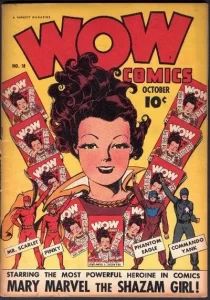
Mary Marvel is the superhero persona of Mary Bromfield, the adopted name of Mary Batson. Mary is Billy Batson’s twin sister, and just like her brother, she transforms into a superhero when she utters the magic word “SHAZAM!”
Mary Marvel was the first female superhero character developed as a spinoff from a male counterpart, years before the introduction of Supergirl. Mary has the same powers of strength, speed, and flight as her older brother, Shazam/Captain Marvel.
Interesting Fact: The original artist for Mary Marvel, Marc Swayze, used images of famous actress Judy Garland as the inspiration for Mary’s face, height, and figure.
First Appearance: Captain Marvel Adventures #18 (Dec. 1942) via Fawcett Publications
3. Tarzan

As an infant, John Clayton II and his parents were marooned in the jungles of Africa when their ship was scuttled during a storm. Both parents soon died, and John was found and raised by a tribe of Mangani apes who gave John the new name of Tarzan. Raised as an ape, Tarzan developed the strength and agility necessary to survive among the beasts of the jungle. With his superior human mind, Tarzan learned to communicate with the apes, other jungle creatures, and local human tribes to become the peak of human development in mind and body.
Later, Tarzan traveled to England to claim his rightful title as Viscount of Greystoke, but he would frequently return to the jungle and travel the world on an assortment of adventures.
Interesting Fact: Tarzan is the only character on this list to have multiple songs composed about him and named after him.
First Appearance: The All-Story magazine (October 1912)
2. The Phantom
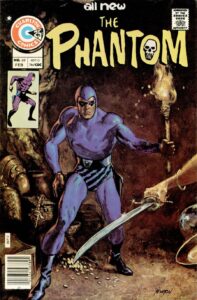
“Beware the Ghost Who Walks!” Contrary to their reputation, The Phantoms are mortals who pass on the responsibilities of their fight against injustice to a new generation when age or death prevents them from continuing to fight injustice around the world. The Phantom mantle has been passed down through the centuries, making it appear as if The Phantom is immortal, hence the moniker of “The Ghost Who Walks.”
Kit Walker is the 21st Phantom to don the trademark purple bodysuit and black domino mask. The Phantom has no superpowers, but he displays above-average athletic ability and intelligence and operates out of a skull-shaped cave in the jungles of the fictional African country of Bangalla
Interesting Fact: The Phantom is the first pulp hero to wear a tight body suit and a domino mask with solid white eyes, making him the first “spandex”-clad hero in the modern superhero era.
First Appearance: Daily national newspapers (February 17, 1936) via King Features Syndicate
1. The Shadow
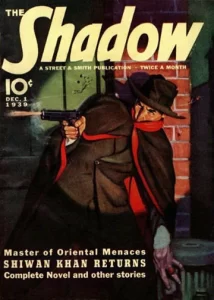
Wealthy socialite Lamont Cranston lives the high life of culture and parties in the big city. What his acquaintances don’t know is that Lamont fights crime as The Shadow, a mysterious figure who can read minds and cloud vision to render himself invisible to criminals everywhere. Wearing his trademark black hat, red-lined cape, and red scarf to cover the lower half of his face, The Shadow strikes unseen and strikes down his enemies before they know he’s there.
The Shadow is famous for his mental abilities to confuse and disable criminals, and he uses two Colt .45 pistols when force is required. The Shadow also develops a vast network of spies and associates to help him gather intelligence on criminal gangs when needed.
Interesting Fact: The character of The Shadow was first conceived as an ominous narrator of the radio show, Detective Story Hour. It wasn’t until after the radio show gained in popularity that The Shadow was spun off into his own stories.
First Appearance: The Living Shadow (April 1931) novel via Street & Smith Publications
How We Ranked
To create this list, it would be impossible to put each character against each other in a match-up of talents, skills, abilities, and powers because each character has its unique origin and mode of operation. In this case, stronger isn’t better.
The measure of success on this list comes down to the admittedly ethereal quality of resonance. Which characters “stick” with the reading audience? Which characters are most adaptable to other forms of media (radio, print, movies, etc.)? Which characters are more memorable?
There’s no simple formula for measuring these qualities, so we used a combination of metrics from Google Trends (search interest over time), Google Search volume (proliferation of content based on each character), and media diversity (number of different platform appearances). If you’re interested in how the characters stacked up, and which characters we researched that didn’t make the Top 15, click here to see the data.
As an Amazon Associate, we earn revenue from qualifying purchases to help fund this site. Links to Blu-Rays, DVDs, Books, Movies, and more contained in this article are affiliate links. Please consider purchasing if you find something interesting, and thank you for your support.
We hope you found this article interesting. Come back for more reviews, previews, and opinions on comics, and don’t forget to follow us on social media:
If you’re interested in this creator’s works, remember to let your Local Comic Shop know to find more of their work for you. They would appreciate the call, and so would we.
Click here to find your Local Comic Shop: www.ComicShopLocator.com
We hope you found this article interesting. Come back for more reviews, previews, and opinions on comics, and don’t forget to follow us on social media:
If you’re interested in this creator’s works, remember to let your Local Comic Shop know to find more of their work for you. They would appreciate the call, and so would we.
Click here to find your Local Comic Shop: www.ComicShopLocator.com

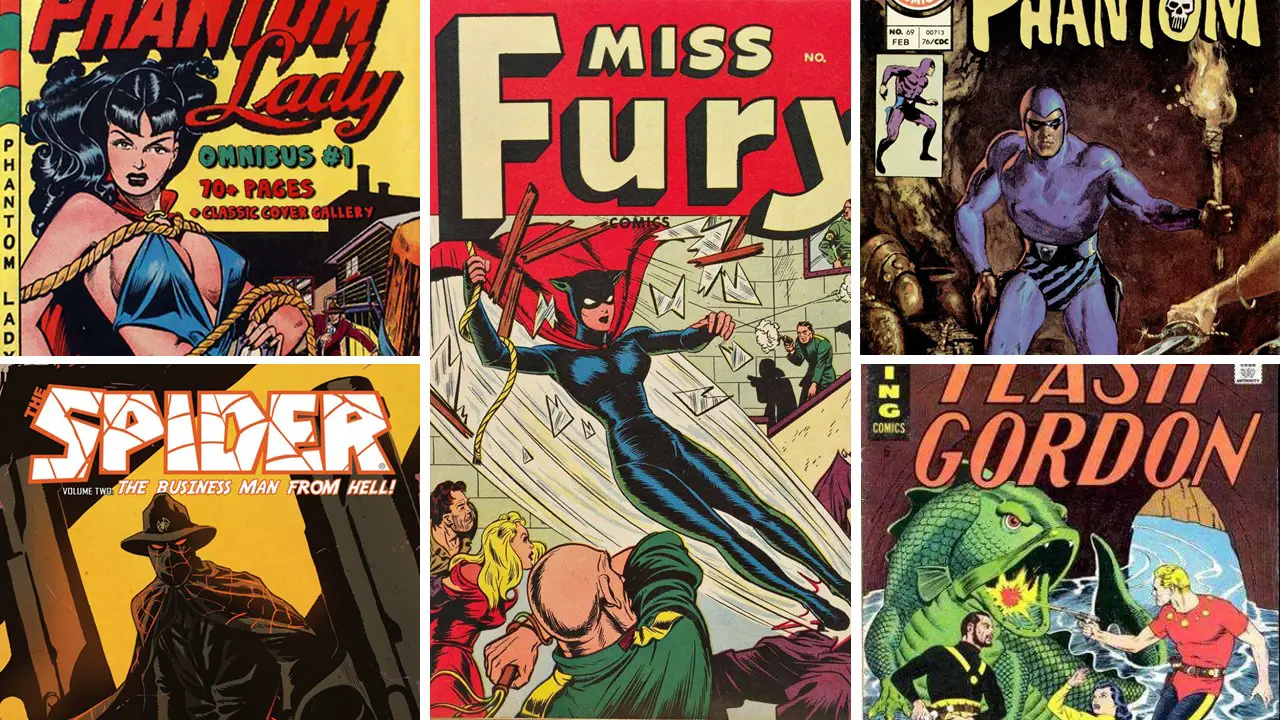
Interesting list that I enjoyed (The Shadow, The Phantom, and Tarzan at #1, #2, and #3 get no argument from me). A few nitpicks though. I feel Conan the Barbarian is ranked way TOO low here. I’d like to say Flash Gordon is too, but honestly today’s cultural mindset probably knows more about the Queen soundtrack than Alex Raymond. And as much as I really like Mary Marvel (one of the great super-hero names of all-time), I’m not certain if I would qualify her as a “pulp” character. Doing so, I think you’d have to add Superman and Captain Marvel to this list, and both would rank much higher than her. Just my two cents.
Thank you for the feedback, Jeff. As you rightly realize, a list of this type is subject to interpretation, but we did our best to make it as fair and reasonable as possible. We’re glad you enjoyed it in the spirit in which it was intended.